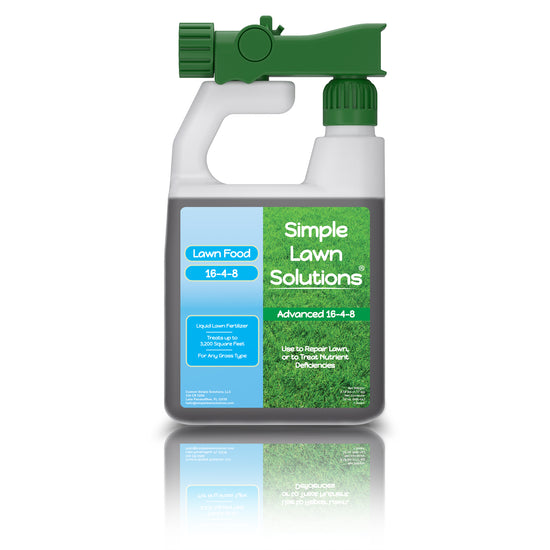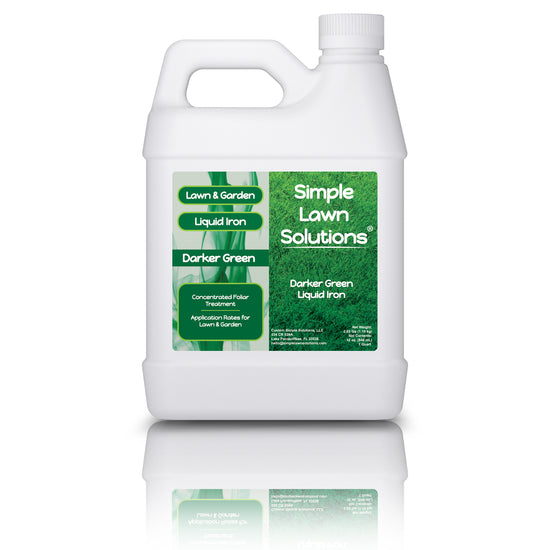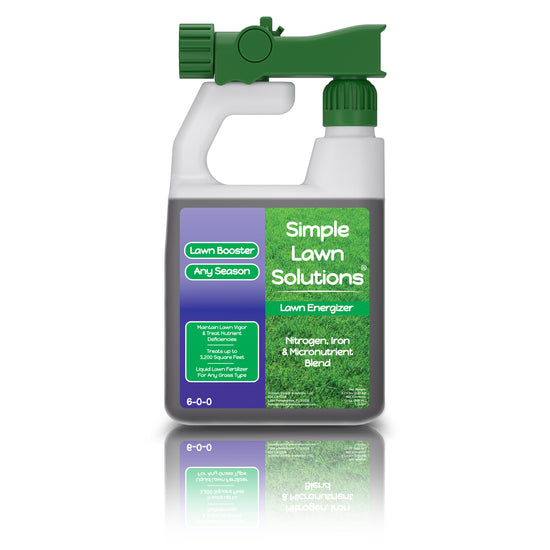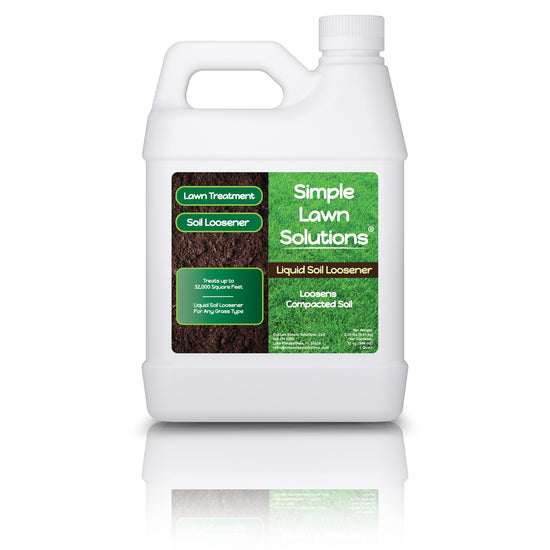Applying fertilizer during the summer can benefit the lawn, but it must be performed to perfection to avoid fertilizer burn, excess growth, and increased stress. A fertilization plan and strategy must be formed, considering the turf type, soil texture and fertility, water availability, and actual climate conditions.
Summer Fertilization for Cool-season Grasses (Kentucky bluegrass, perennial ryegrass, tall fescue)
Summer brings many environmental stresses, such as increased temperatures, drought, high humidity, and disease pathogens. Applying high nitrogen to cool-season grasses during these stressful times can have adverse results and even be deadly if miscalculated. Cool-season grasses go through a tremendous amount of stress during the summer months. When fertilization occurs, it can promote rapid growth at a fast rate, which depletes all of the energy reserves within the grass plant that are required for summertime survival.

How to Protect Cool-Season Grasses During Summer Stress
The survival of cool-season grasses during the summer begins in the spring with the preparation of fertilization, aeration, and mowing at the proper height of cut. Once temperatures rise above 85° Fahrenheit, cool-season grasses have an internal defense mechanism to protect themselves from harsh conditions. Photosynthesis efficiency declines above 85° Fahrenheit, and the stressed plant's respiration exceeds photosynthesis, leading to a net energy loss.
Transpiration increases with the heat and depletes the soil moisture. Cool-season grasses can’t take up water fast enough to match the loss, leading to wilting and desiccation. As a result of these reactions, root growth is reduced, and the grasses are looking for additional water to meet their needs. When grass plants have less access to moisture, they enter into drought stress.
Once drought stress occurs, most cool-season grasses will enter dormancy and cease growth—the lack of irrigation results in the grass leaf tissue turning brown. In the dormant stage, the grass becomes survival mode and redirects its energy reserves to the roots and crowns. Cool-season grasses can survive between 2 and 6 weeks of dormancy, but extended drought without irrigation may result in permanent damage or thinning.
Common Cool-season Turfgrass Diseases
Cool-season grasses growing in the summer heat stress and high humidity can favor foliar diseases during this time. Mowing, fertilization, and seed head control directly influence disease development. Therefore, it is of the utmost importance that all maintenance practices are adequately performed during this sensitive time frame. Increasing the height of the cut even slightly can decrease the occurrence of certain diseases.
Brown patches occur in cool-season grasses during high heat and humidity. Brown patch is the most widespread turfgrass disease on all grasses. It happens on bentgrass, tall fescue, perennial rye, and annual bluegrass during warm weather when nighttime temperatures are above 68° Fahrenheit and the foliage remains wet for an extended period.

Low N levels, low mowing heights, micronutrient deficiency, dry soil, heavy dews, soil compaction, and excessive thatch thickness favor dollar spot. Conditions become favorable for the formation of this disease at 55° F and are more favorable between 70° F and 84° F, especially when dew is present for 10 hours or more. Although a persistent disease, dollar spot does typically not cause turfgrass death.
Pythium blight disease can occur on all cool-season grasses, such as creeping bentgrass, annual bluegrass, Kentucky bluegrass, and perennial ryegrass. It can be especially severe on newly established grasses. It is most likely to occur when temperatures exceed 85° F, relative humidity is high, and the foliage is wet for more than 10 hours a day and several consecutive days.
Anthracnose can occur on many cool-season grasses. It appears with leaf spot and thins annual bluegrass, fine leaf fescue, creeping bentgrass, and specific Kentucky bluegrass cultivars. This disease can occur when there is limited growth and temperatures are between 80° F and 90° F, and when the soil is dry, leaves are wet, and high humidity occurs on cool-season grasses.
These diseases require optimum weather conditions and can be associated with overwatering, high nitrogen fertilizers, and excessive thatch thickness. Therefore, using low-rate, slow-release nitrogen (e.g., methylene urea, urea triazone) is best during summer on cool-season grasses. It is essential to perform “spoon feeding” on cool-season grasses during the summer, as it is a safe practice. Avoid fertilization if the cool-season grasses are dormant or heat-stressed.
Warm-Season Grasses (e.g., bermudagrass, zoysiagrass, St. Augustinegrass, centipedegrass)
Although warm-season grasses perform best when temperatures rise in the summer, they can still be susceptible to certain diseases when fertilized with high-nitrogen fertilizers. When combined with favorable weather conditions and moisture, diseases can devastate warm-season grasses like cool-season grasses. Brown patches, grey leaf spots, Helminthosporium leaf spots, pythium root rot, and anthracnose can occur in warm-season turfgrasses. These diseases are either a direct cause or aggravated by applying high Nitrogen fertilizers during the summer months.

Just as with cool season grasses fertilized in the summer, warm season grasses can also be “spoon fed” at ½ lb - 1 lb. of nitrogen per 1000 square feet every 4 - 6 weeks. Using slow-release forms of nitrogen will extend the feeding period to a low but steady nitrogen supply. Monitor the growth of the turf during the summer and avoid lush growth because the grass plant will become succulent and favor disease conditions.
Summer Fertilization for Warm-season Grasses
Using slow-release nitrogen will reduce the risk of foliar burn and provide consistent feeding to the turf during stress, like heat and drought. Apply the fertilizer in the early morning or late evening, and water the fertilizer immediately after application.
Avoid high-nitrogen fertilizers because they can cause excessive growth and weaken the turf under heat stress. Combining fertilizer with micronutrients and iron or magnesium can enhance a good green color without a growth surge. You can also perform a soil test to see what is available for the turfgrass to grow, and never give more than it needs or is available.
Do not fertilize when the grass is in heat or drought stress with water restrictions. Certain cool-season grasses will turn brown and go dormant at specific temperatures. Making the mistake of fertilizing dormant grass is not beneficial to the plant and can contaminate the environment with surface runoff and internal leaching.
Also, avoid fertilization just before or during extreme heat waves. Monitor the weather conditions like temperature, humidity, and moisture levels within the soil and leaf tissue, as the right conditions favor disease formation. Adding relative humidity and temperature together can be a beneficial approach to determining when and when not to fertilize. When the sum of the two combined factors equals or exceeds 150, be cautious, as this is the perfect setting for serious problems when applying nitrogen fertilizers.
What Type of Fertilizer Should Be Applied
Urea triazone is an excellent option for any time of the season, but especially during the hot summer months, because it is a slow-release nitrogen. Iron sulfate or Fe-EDDHA is fantastic for quick color and slow growth. Balancing fertilizer applications with 15-0-15 or 16-4-8 is a safe option, especially when “spoon-feeding” the grass.
If the soil test results display low nutrient levels, apply what is deficient alongside low percentages of nitrogen. Constantly water the nutrients to activate and supply energy to the leaf tissue and soil. Blindly applying fertilizers without soil testing results is a recipe for failure if weather conditions are optimum for disease pathogens.
Disease Control During Summer
Turfgrass disease is a detrimental condition that develops from a continuous interaction between a causal agent and a host plant. Infectious diseases originate from an interaction between a host plant and a disease organism, and an environment favorable for the organism to attack. All turfgrasses are susceptible to these diseases, and will sometimes attack healthy turf when all the proper and correct cultural practices have been performed. Treating turfgrasses that have contracted a disease is needed in many cases.
Fungicides, in coordination with cultural practices, can ensure your lawn remains alive and safe when applying fertilizers. Continual daily monitoring can assist significantly in detecting diseases during the summer when fertilizers are used. Some diseases, such as pythium, can destroy a lawn and high-profile turfgrass areas within 24-48 hours if not treated immediately. Therefore, a preventive fungicide program should be considered when conditions are favorable for cool and warm-season grasses. Applying fungicides before favorable conditions could save your lawn after applying fertilizers. As the old saying goes, ‘an ounce of prevention is worth a pound of cure’ is so true in this case. Happy fertilization this summer!










